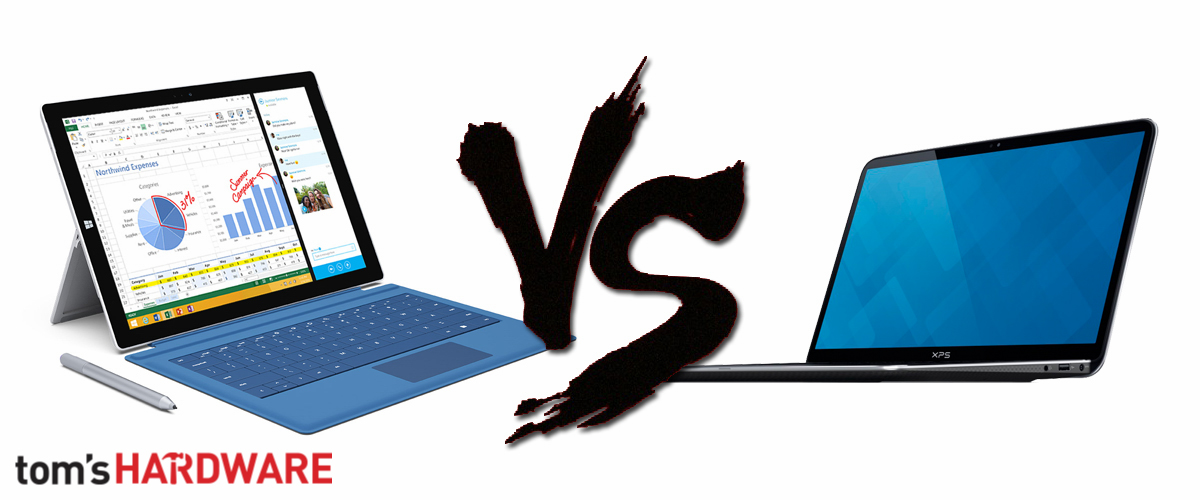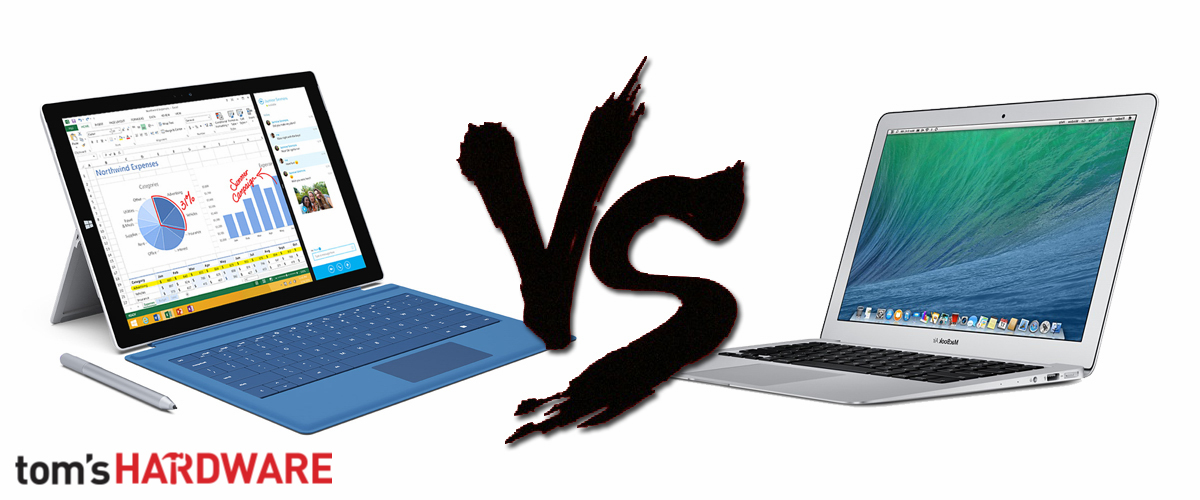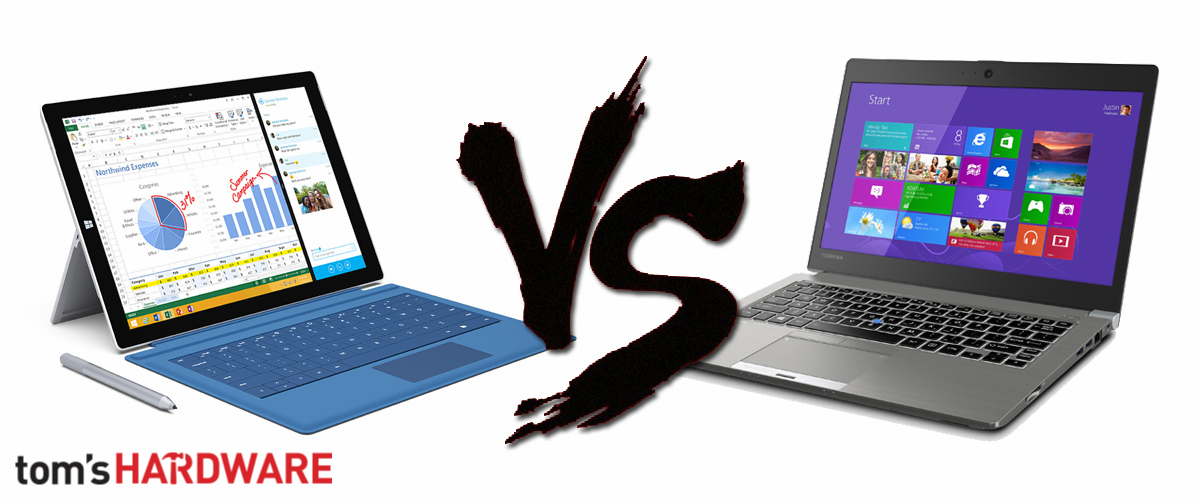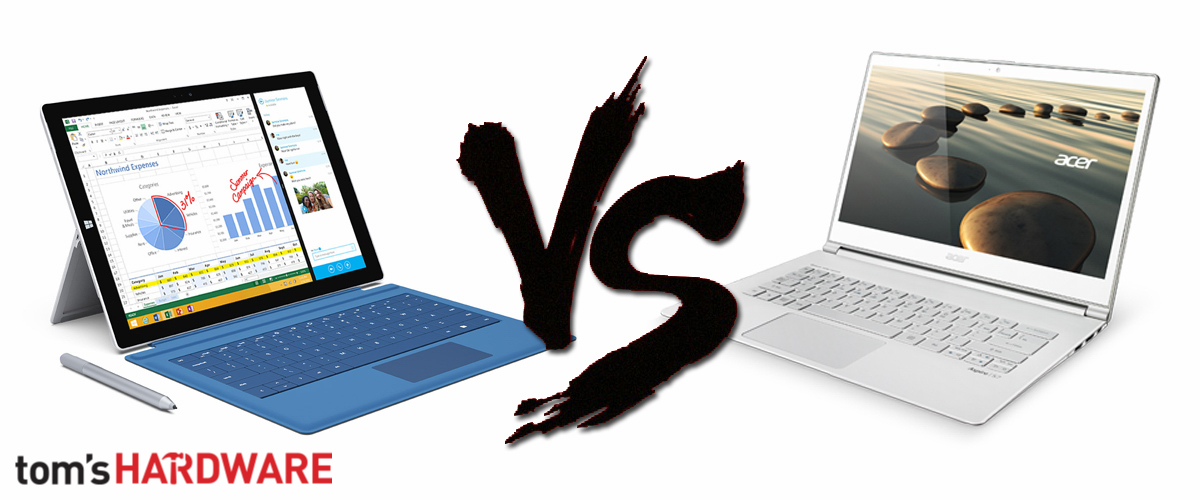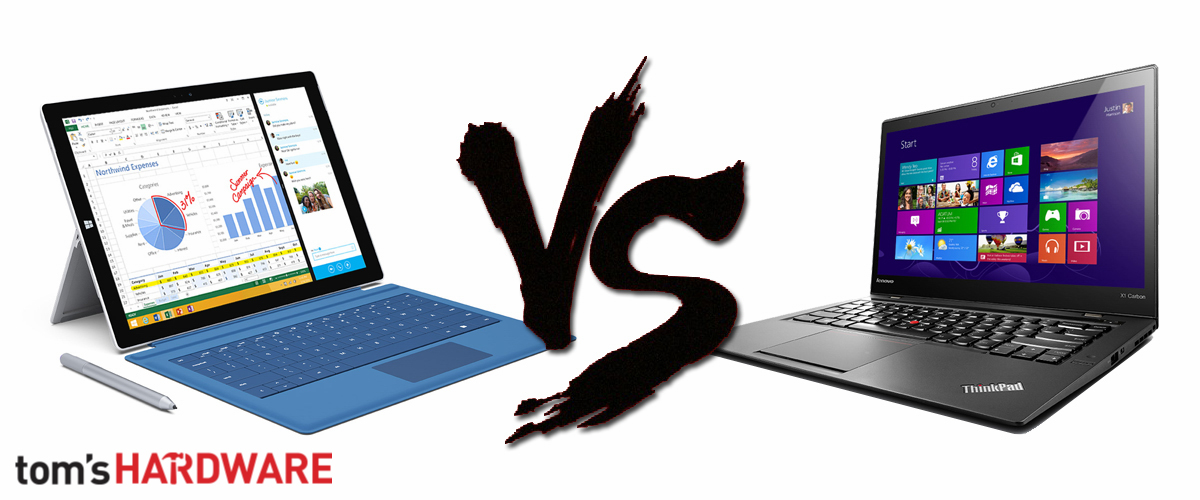Can Surface Pro 3 Replace Your Ultrabook? (Updated)
Microsoft is claiming that the Surface Pro 3 is "the tablet that can replace your laptop." Let's see how it stacks up on paper compared to leading Ultrabooks.
When Microsoft unveiled its latest piece of hardware last week, Microsoft's Panos Panay made the bold claim that with the Surface Pro 3 you can finally have a device that can "do it all." Despite the fact that this same claim was made for the previous two Surface Pros, it is clear that this time Microsoft is even more aggressively positioning the Pro 3 as a laptop replacement, rather than just a tablet. At the event, most of the time was spent comparing it to the MacBook Air and how changes to its kickstand and keyboard cover design makes it more suited for use as a laptop than older Surfaces.
While Microsoft's presentation put forward a convincing case as to why the Surface Pro 3 is a viable replacement for your current notebook, we still need to put that claim to the test. We are already in the midst of testing our review unit, and you can read our initial hands-on impressions here, but we also wanted to see, at least on paper, how the Pro 3 stacks up to other Ultrabooks currently available.
For each model of the Surface Pro 3, we looked for comparable, in features and price, 13.3-inch business class Ultrabooks, and compared just the specifications to see who came out on top. We are not passing judgement on how the Surface's form factor performs as a notebook in this comparison. We chose business class machines, because since the Pro 3 runs Windows 8.1 Pro, it's definitely geared towards professionals rather than home users. In all cases, the dimensions, weight and pricing of the Pro 3 was based on the inclusion of a keyboard cover.
UPDATE: In a Reddit AMA yesterday, Panos Panay and the Surface team provided more details about the Surfaces Pro 3, including some more detailed CPU and GPU specifications, so we have updated the each section below to reflect this.
Surface Pro 3 64 GB Core i3 model compared to a Core i3 Dell XPS 13
| Header Cell - Column 0 | Surface Pro 3 | Dell XPS 13 |
|---|---|---|
| CPU | Intel 1.7 GHz Core i3-4010U | |
| Graphics | Intel HD Graphics | Intel HD Graphics 4400 |
| RAM | 4 GB DDR3 | 4 GB DDR3 |
| Storage | 64 GB | 128 GB SSD |
| Display | 12-inch 3:2 Full HD Plus IPS (2160 x 1440, 216 ppi) | 13.3-inch 16:9 Full HD IPS (1920 x 1080, 166 ppi) |
| Touchscreen | Yes | No (optional upgrade) |
| Pen Input | Yes, Pen Included | No |
| Optional Docking Station | Yes | No |
| Wireless | Wi-Fi 802.11 a/b/g/n/ac, BT 4.0 | Wi-Fi 802.11 a/b/g/n/ac, BT 4.0 |
| Ports | 1 x USB 3.0, microSD, mini DisplayPort, headphone | 2 x USB 3.0, mini DisplayPort, headphone |
| Camera | 5MP front & rear | HD front |
| Battery Life | Up to 9 hours | Up to 11 hours |
| Dimensions* | 11.5" x 7.93" x 0.55"(292 x 201.3 x 14 mm) | 12.4" x 8.1" x 0.70"(316 x 205 x 18 mm) |
| Weight* | 2.41 lbs (1.095 kg) | 2.95 lbs (1.34 kg) |
| OS | Windows 8.1 Pro | Windows 8.1 Pro |
| Price* | $930 | $1079 |
*including Type Cover
The Dell XPS 13 can be configured with a Core-i7, 8 GB of RAM and a bigger SSD, so it could have been used to compare to the higher-end Surface Pro 3 too. However, it is also one of the few 13-inch business class Ultrabooks that can also be bought with the lower-end Core i3 CPU. It, like the Surface, is made from premium materials: in this case carbon fiber, magnesium and aluminum.
Since we do not yet know which exact i3 is in the Pro 3, we cannot directly compare CPU performance The base model Surface Pro 3 is powered by a Core-i3 Y series processor, which means it is not going to be as capable of more demanding tasks. This also means that the GPU is only an Intel HD 4200, so on the performance front, the XPS is the clear winner here. Nevertheless, as you can see from this chart, the specifications where the Surface wins are screen resolution, pen-input, docking functionality and dimensions. However, once you add the keyboard cover, the Pro 3’s advantages in thinness and weight aren’t that great. The XPS 13 does have better battery life and one more USB 3.0 port, but is more expensive. On the storage front, the smallest sized SSD available in any current generation Ultrabook is 128 GB, so the entry-level Pro 3 is always going to have a price advantage due to the savings of having such limited capacity and a lower-end CPU. In spite of that, in reality, it would be hard for us to recommend anyone buy a notebook with such a small amount of storage.
Get Tom's Hardware's best news and in-depth reviews, straight to your inbox.
Surface Pro 3 128 GB Core i5 model compared to a 13-inch Core i5 MacBook Air
| Header Cell - Column 0 | Surface Pro 3 | 13-inch MacBook Air |
|---|---|---|
| CPU | Intel 1.9 GHz Core i5-4300U | Intel 1.4 GHz Core i5-4260U |
| Graphics | Intel HD Graphics 4400 | Intel HD Graphics 5000 |
| RAM | 4 GB DDR3 | 4 GB DDR3 |
| Storage | 128 GB | 128 GB SSD |
| Display | 12-inch 3:2 Full HD Plus IPS (2160 x 1440, 216 ppi) | 13.3-inch 16:10 HD(1440 x 900, 128 ppi) |
| Touchscreen | Yes | No |
| Pen Input | Yes, Pen Included | No |
| Optional Docking Station | Yes | No |
| Wireless | Wi-Fi 802.11 a/b/g/n/ac, BT 4.0 | Wi-Fi 802.11 a/b/g/n/ac, BT 4.0 |
| Ports | 1 x USB 3.0,microSD, mini DisplayPort, headphone | 2 x USB 3.0, SDXC slot, Thunderbolt, headphone |
| Camera | 5MP front & rear | HD front |
| Battery Life | Up to 9 hours | Up to 12 hours |
| Dimensions* | 11.5" x 7.93" x 0.55"(292 x 201.3 x 14 mm) | 12.8" x 8.94" x 0.68"(325 x 227 x 17 mm) |
| Weight* | 2.41 lbs (1.095 kg) | 2.96 lbs (1.35 kg) |
| OS | Windows 8.1 Pro | OS X 10.9 Mavericks |
| Price* | $1130 | $1000 |
*including Type Cover
The MacBook Air was the primary target for the Surface Pro 3 at the launch event, and even though it's not considered a business class machine, it is a very popular tool for many professionals, especially tech journalists!
In this case, when you compare the base 13-inch MacBook Air with the equivalent Core i5-powered Surface, Apple comes out on top when it comes to pricing, only because the cost of the keyboard cover moves up the Pro 3's price. We think it might be a good idea for Microsoft to bundle the Surface Pro 3 with a keyboard for a reduced price. On the specifications side of things, the Air and Pro 3 are pretty evenly matched, apart from the screen specs, where the Surface has a distinct advantage. The Mac's screen is substantially lower resolution, is not IPS, and there is no touch screen option. On the other hand, the Air does have much better battery life and an extra USB 3.0 port.
Surface Pro 3 256 GB Core i5 model compared to a 13.3-inch Toshiba Portege Z30
| Header Cell - Column 0 | Surface Pro 3 | Toshiba Portege Z30 |
|---|---|---|
| CPU | Intel 1.9 GHz Core i5-4300U | Intel 1.9 GHz Core i5-4300U |
| Graphics | Intel HD Graphics 4400 | Intel HD Graphics 4400 |
| RAM | 8 GB DDR3 | 8 GB DDR3 |
| Storage | 256 GB | 256 GB SSD |
| Display | 12-inch 3:2 Full HD Plus IPS (2160 x 1440, 216 ppi) | 13.3-inch 16:9 HD TN (1366 x 768, 118 ppi) |
| Touchscreen | Yes | Yes |
| Pen Input | Yes, Pen Included | No |
| Optional Docking Station | Yes | Yes |
| Wireless | Wi-Fi 802.11 a/b/g/n/ac, BT 4.0 | Wi-Fi 802.11 a/b/g/n/ac, BT 4.0 |
| Ports | 1 x USB 3.0, microSD, mini DisplayPort, headphone | 3 x USB 3.0, VGA, SDXC slot, Ethernet, HDMI, fingerprint reader, headphone |
| Camera | 5MP front & rear | HD front |
| Battery Life | Up to 9 hours | Up to 12.5 hours |
| Dimensions* | 11.5" x 7.93" x 0.55" (292 x 201.3 x 14 mm) | 12.44" x 8.94" x 0.70" (316 x 227 x 17.9 mm) |
| Weight* | 2.41 lbs (1.095 kg) | 2.6 lbs (1.20 kg) |
| OS | Windows 8.1 Pro | Windows 8.1 Pro |
| Price* | $1430 | $1615 |
*including Type Cover
Toshiba's Portege Z30 is one of the lightest business grade Ultrabooks currently available and is an excellent example of a machine designed for enterprise use first and foremost. Like the Surface Pro 3, it is made mostly from magnesium, so it is extremely light. In fact, it comes the closest in weight to the Pro 3 with a keyboard cover.
Specifications-wise, the Z30 model we configured on Toshiba's site is comparable to the Pro 3, but it has quite a few extra features not found on Microsoft's hybrid. It has two more USB 3.0 ports, a fingerprint reader, a full-sized VGA port and Ethernet port, all pretty impressive given that it is only a few mm thicker than the Pro 3 with the Type Cover. It also has much better (claimed) battery life. However, even though you can configure the Z30 with a touchscreen, it has a middling resolution of only 1366 x 768, and to add insult to injury, it isn't even an IPS panel. Clearly, Toshiba is not going after graphics professionals with the Z30.
The Surface Pro 3 does handily beat it on price though. To configure a Z30 at the same price point as the Surface would mean sacrificing the touchscreen and dropping down to 4 GB of RAM.
Surface Pro 3 256 GB Core i7 model compared to a 13.3-inch Acer Aspire S7-392-9404
| Header Cell - Column 0 | Surface Pro 3 | Acer Aspire S7-392-9404 |
|---|---|---|
| CPU | Intel Core | Intel 1.8 GHz Core i7-4500U |
| Graphics | Intel HD Graphics | Intel HD Graphics 4400 |
| RAM | 8 GB DDR3 | 8 GB DDR3 |
| Storage | 256 GB | 256 GB SSD |
| Display | 12-inch 3:2 Full HD Plus IPS (2160 x 1440, 216 ppi) | 13.3-inch 16:9 Full HD IPS (1920 x 1080, 166 ppi) |
| Touchscreen | Yes | Yes |
| Pen Input | Yes, Pen Included | No |
| Optional Docking Station | Yes | No |
| Wireless | Wi-Fi 802.11 a/b/g/n/ac, BT 4.0 | Wi-Fi 802.11 a/b/g/n, BT 4.0 |
| Ports | 1 x USB 3.0, microSD, mini DisplayPort, headphone | 2 x USB 3.0, SDXC slot, HDMI, headphone |
| Camera | 5MP front & rear | HD front |
| Battery Life | Up to 9 hours | Up to 8 hours |
| Dimensions* | 11.5" x 7.93" x 0.55" (292 x 201.3 x 14 mm) | 12.7" x 8.8" x 0.50" (322.6 x 223.5 x 12.7 mm) |
| Weight* | 2.41 lbs (1.095 kg) | 2.87 lbs (1.30 kg) |
| OS | Windows 8.1 Pro | Windows 8.1 Pro |
| Price* | $1680 | $1600 |
*including Type Cover
The Acer Aspire S7 is not really a business class notebook. It is more of a high-end consumer model, but it can be configured with Windows 8 Pro, still making it a good choice for professionals. It is also very well made from premium materials, with an aluminum unibody chassis and a very attractive Gorilla Glass 2 clad lid.
Like the i3-powered version of the Surface Pro 3, we do not, as of yet, know with which i7 CPU it will ship. The i7 model is not going to be available until the end of August, likely because Microsoft wants to use the refreshed 2 GHz Core i7-4510U CPU that was just released by Intel in April. It is disappointing, with the GPU specs for the i7 Pro 3 still shown as HD 4400, that Microsoft did not decide to go with a ULT i7 that has HD 5000 graphics It looks like we spoke too soon, because in yesterday’s Reddit AMA it was announced that the Core i7 model uses the 1.7 GHz i7-4650U, that also has HD 5000 graphics. This means that the Pro 3 runs the fastest ULT Core i7 processor, and is one of the few Windows machines available with this chip (it is also found in the i7 MacBook Air). The Aspire S7 still uses the a CPU from the initial Haswell-ULT revision, the 1.8 GHz i7-4500U, meaning the Surface will be slightly faster, but they both have the same RAM and storage capacity. The HD 5000 GPU in the Surface will be substantially faster than the HD 4400 in the S7. The Pro 3 has a better screen, but the 1080p IPS panel on the S7 is still decent. However, the Surface does have the big advantage of pen input, something it has over all the notebooks in this comparison. Since the S7 came out last year, it is the only machine here that doesn’t support wireless-AC, and its battery life is also the shortest, even less than the Surface’s. Be that as it may, we’re pretty sure that the 4650U CPU and HD 5000 GPU will probably impact the Surface’s claimed 9 hours of life). Acer sacrificed battery capacity to get the S7 as thin as possible —it is even thinner than the Pro 3 (with the Type cover).
On the price side, the Acer S7 ends up being a bit cheaper when similarly configured to the Surface Pro 3, but of course the Pro has a better processor, better screen and possibly better battery life.
Surface Pro 3 512 GB Core i7 model compared to a Lenovo ThinkPad X1 Carbon (2014) Core-i7 Ultrabook
| Header Cell - Column 0 | Surface Pro 3 | ThinkPad X1 Carbon (2014) |
|---|---|---|
| CPU | Intel Core | Intel 2.1 GHz Core i7-4600U |
| Graphics | Intel HD Graphics | Intel HD Graphics 4400 |
| RAM | 8 GB DDR3 | 8 GB DDR3 |
| Storage | 512 GB | 512 GB SSD |
| Display | 12-inch 3:2 Full HD Plus IPS (2160 x 1440, 216 ppi) | 14-inch 16:9 WQHD IPS (2560 x 1440, 210 ppi) |
| Touchscreen | Yes | Yes |
| Pen Input | Yes, Pen Included | No |
| Optional Docking Station | Yes | No |
| Wireless | Wi-Fi 802.11 a/b/g/n/ac, BT 4.0 | Wi-Fi 802.11 a/b/g/n/ac, BT 4.0 |
| Ports | 1 x USB 3.0, microSD, mini DisplayPort, headphone | 2 x USB 3.0, mini DisplayPort, HDMI, fingerprint reader, headphone |
| Camera | 5MP front & rear | HD front |
| Battery Life | Up to 9 hours | Up to 8.5 hours |
| Dimensions* | 11.5" x 7.93" x 0.55" (292 x 201.3 x 14 mm) | 13.03" x 8.94" x 0.55" (330.96 x 227.1 x 14 mm) |
| Weight* | 2.41 lbs (1.095 kg) | 2.8 lbs (1.27 kg) |
| OS | Windows 8.1 Pro | Windows 8.1 Pro |
| Price* | $2080 | $2130 |
*including Type Cover
For the last comparison, we decided to pick what in our opinion is the top-of-the-range business Ultrabook on the market today: the Lenovo X1 Carbon (2014). The X1 is one of the lightest machines in this comparison, after the Surface Pro 3 and Toshiba Z30, and it matches the Surface's thickness at 14 mm. Like the Pro, it is also made from premium materials, in this case carbon-fiber. However, the X1 takes things to the next level, meeting eight out of nine military specifications for durability, and by having a spill-resistant keyboard.
Specifications-wise, we were able to configure the X1 with similar specs to the top-end i7 Surface Pro 3. Since we do not know exactly which Core i7 the Surface will come with, we cannot directly compare CPU performance, but as mentioned before, it is likely to be the 2 GHz 4510U, which is only slightly slower than the 2.1 GHz 4600U in the X1 The i7-4600U in the X1 does have a higher base clock speed than the Pro’s i7-4650U but still has the slower HD 4400 integrated GPU. The HD 5000 in the Surface Pro 3 should provide much better performance in applications (and games!) that can take advantage of it. The Lenovo is the only notebook in this roundup that has a comparable screen to the Pro 3’s. It has a 2560 x 1400 WQHD IPS touchscreen, and despite it being 14-inches, the still X1 is a very compact machine and is no bigger than other notebooks in this list that all have 13-inch displays. Like all the notebooks here, it has more USB ports than the Surface, and like the Z30 has a fingerprint reader. On the other hand, its claimed battery life, 8.5 hours, is not as good as the claimed life of the Surface, again because Lenovo decided to sacrifice capacity to keep the X1’s thickness down. However, Lenovo has equipped the X1 with their RapidCharge feature that can charge it 80% in “just under an hour.” Microsoft does not advertise any rapid charging feature for the Surface, and we have not been able to test how long it takes to charge on our demo unit as of yet.
As for pricing, both the top-end Surface Pro 3 and X1 Carbon are $2000+ tools, which is quite a chunk of change to drop on a notebook, no matter the specs. However, it does demonstrate that if you compare the best Pro 3's price to a comparable business Ultrabook, it isn't actually any more expensive when you look at it from an apples-to-apples perspective.
So, can the Surface Pro 3 replace your Laptop?
Again, the point of this article is not to determine how well the Surface Pro 3 performs in the role of notebook since we haven't had time yet to test it fully. However, we did want to see from a specification and pricing perspective how the Pro 3 (with the keyboard cover) stacks up to other thin-and-light notebooks. Looking at the comparisons we have made here, it does look like Microsoft has done their homework, since each Surface Pro 3 model does seem to be competitively priced with similar spec'd business class Ultrabooks. It is also good to see Microsoft equip the top-end model with not only a faster CPU, but also a faster GPU too. So, yes, at least from looking at just the specifications and price, the Surface Pro 3 can replace your notebook. However, the question remains, how does the Surface perform physically in the role of a notebook? While we still need to draw our final conclusions, our initial impressions are good, but Microsoft does need to bundle the Type Cover with the Surface.
For a second opinion on whether the Surface Pro 3 is a good laptop replacement, check-out our sister publication Laptop’s article 5 Reasons Surface Pro 3 Shouldn’t Replace Your Laptop.
Follow Alex Davies@AlexBDavies. Follow us @tomshardware, on Facebook and on Google+.
-
alex davies Stay tuned for an update to this post shortly. Microsoft released more info about the i3 and i7 models in a Reddit AMA yesterday.Reply -
classzero As with the previous two models, the surface is very expensive. I would rather have a laptop with a dedicated GPU for less than their i7. The below link will direct you to a Asus - 15.6" Touch-Screen Laptop - Intel Core i7 - 8GB Memory - 1TB Hard Drive - Aluminum/Black with dedicated GPU. Far better laptop for half the price.Reply
http://www.bestbuy.com/site/asus-15-6-touch-screen-laptop-intel-core-i7-8gb-memory-1tb-hard-drive-aluminum-black/3703007.p?id=1219093053506&skuId=3703007&st=pcmcat287600050003_categoryid$abcat0502000&cp=1&lp=1 -
RedJaron Reply
That's a poor, nearly invalid, comparison. A big point to the Surface, and ultrabooks in general, is the size and weight. Yes, I can get an i5, 4GB RAM, and a 1TB HDD in a laptop for $500, but that's going to be a 15" plastic chassis that weighs nearly 6lbs. Try stuffing those same specs into a premium material chassis, cut the weight by half, and see what you can find. The Surface Pro has actually been priced well since its release when comparing its internals, size, weight, and overall fit and finish to the rest of the market.13382034 said:As with the previous two models, the surface is very expensive. I would rather have a laptop with a dedicated GPU for less than their i7. The below link will direct you to a Asus - 15.6" Touch-Screen Laptop - Intel Core i7 - 8GB Memory - 1TB Hard Drive - Aluminum/Black with dedicated GPU. Far better laptop for half the price.
I think the biggest letdown of the Surface 3 is the single i3 model. I think an i3 / 128 GB model would sell well, maybe even an i3 / 256 GB model. But I'm still hoping for a Bay Trail Surface at some point. Give it a nice 12" IPS screen ( would really like a 1920x1200,) a 128 GB SSD, and price it around $500. I don't think you could keep them in stock. -
red77star No it can't cause Surface runs garbage video chip in form of HD4400. I can get ultrabook with AMD A10 cpu -> much better thing.Reply -
gm0n3y I really wanted to jump on the ultrabook bandwagon, but the prices have just been too high for me. The same goes for the Surface Pro. I'd be willing to pay maybe a $100 premium for having a good touch screen interface, which puts the Surface at a better price than the competition. However, it's still at least $200 too expensive for me.Reply
That being said, the Surface Pro just keeps getting better and is certainly the best tablet on the market. Maybe by this time next year the prices will have come down to a point where I'll buy one. 64GB would be enough space for me, but how much space does the OS take. I'd want at least 50GB free space to play with. -
industrial_zman ReplyNo it can't cause Surface runs garbage video chip in form of HD4400. I can get ultrabook with AMD A10 cpu -> much better thing.
You can't get an Ultrabook with an AMD processor. That's an Intel proprietary platform. You might have an "ultra light" computer with AMD.
Have you even used any of the new Intel HD2XXX, HD4XXX or HD5XXX chips? I have an AiO desktop with an HD2500. It plays most FPS and sandbox games at 720P with refresh rates higher than 50FPS. -
RedJaron Reply
Try again. I think you're missing a big point. Ultrabooks and similarly small laptops aren't intended for gaming. They're for productivity on the move.13383302 said:No it can't cause Surface runs garbage video chip in form of HD4400. I can get ultrabook with AMD A10 cpu -> much better thing.
Taking a look on Newegg right now, the best I can find is an A6 / 64 GB SSD for $700 and A6 / 128 GB SSD for $890. Neither of which offer more than 5 hours battery, 802.11 ac wireless, high resolution screen, or a weight under 3 lbs. Now perhaps I may have missed the one you're talking about, so can you please point me to a laptop that runs an A10, has a touchscreen with a resolution of at least 1920x1080 ( IPS panel preferred, ) and weighs less than 5 lbs?
-
Treynolds416 I'll be watching the surface 3 pro pretty closely over the next few months, I need a new computer for college and this seems sooo close to what I need. I would order it right now if the keyboard cover was $50 as opposed to $130, but I guess I'll have to see what August bringsReply -
alex davies ReplyAs with the previous two models, the surface is very expensive. I would rather have a laptop with a dedicated GPU for less than their i7. The below link will direct you to a Asus - 15.6" Touch-Screen Laptop - Intel Core i7 - 8GB Memory - 1TB Hard Drive - Aluminum/Black with dedicated GPU. Far better laptop for half the price.
http://www.bestbuy.com/site/asus-15-6-touch-screen-laptop-intel-core-i7-8gb-memory-1tb-hard-drive-aluminum-black/3703007.p?id=1219093053506&skuId=3703007&st=pcmcat287600050003_categoryid$abcat0502000&cp=1&lp=1
The article has been updated to show that the i7 Pro 3 has a better GPU than we originally thought.
-
alex davies ReplyNo it can't cause Surface runs garbage video chip in form of HD4400. I can get ultrabook with AMD A10 cpu -> much better thing.
The article has been updated to show that the i7 Pro 3 has a better GPU than we originally thought, the HD 5000.

